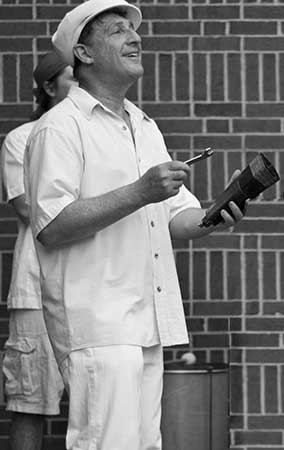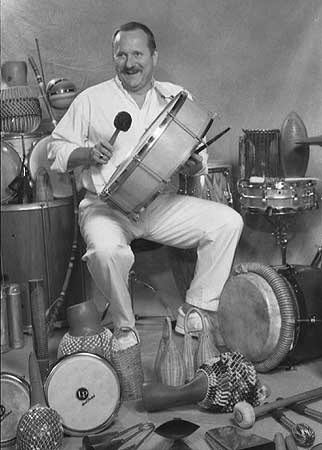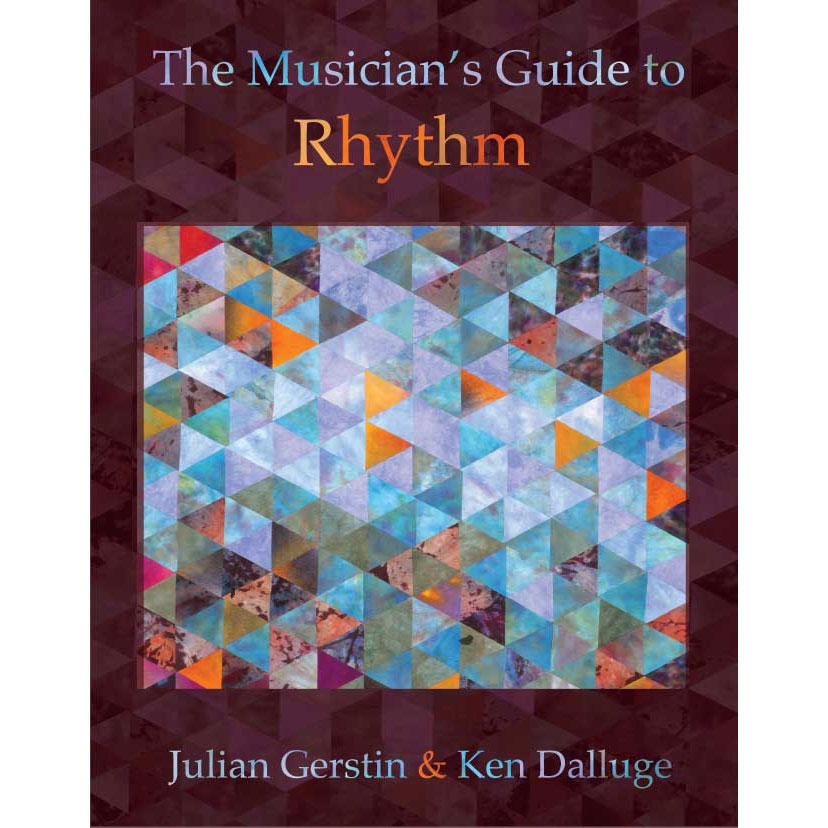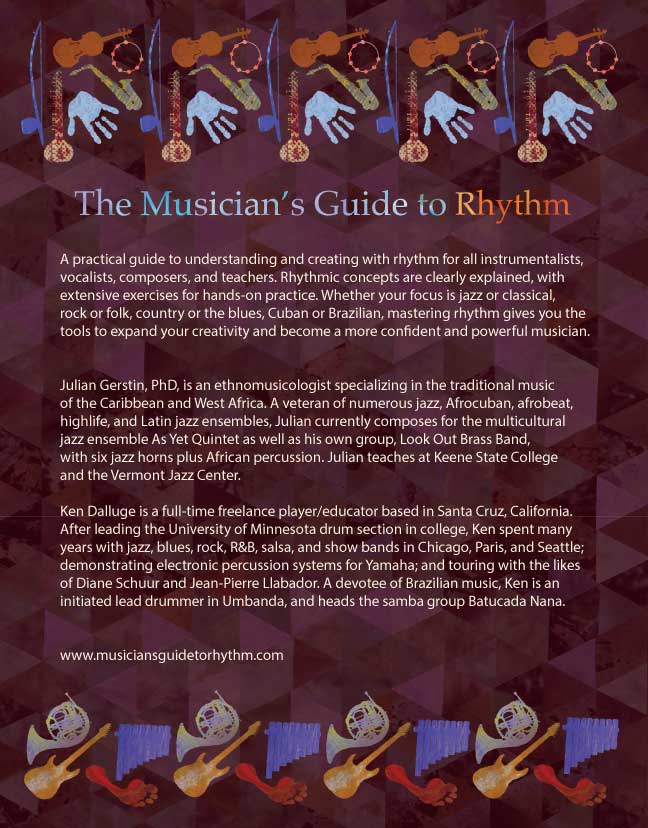The Musician’s Guide To Rhythm is something new in the world of music education: a practical guide to rhythm for all instrumentalists, vocalists, composers, and teachers. Expand your rhythmic skills and creativity on any instrument! MGR introduces basic and complex rhythmic concepts clearly and progressively, demonstrates their melodic potential, and provides extensive hands-on exercises for immediate results. Whether your focus is jazz or classical, rock or folk, country or the blues, Cuban or Brazilian, mastering rhythm gives you the tools to expand your creativity and become a more confident and powerful musician.
Among the most detailed descriptions of rhythm ever published, which
simultaneously pays attention to mathematical aspects, aesthetics and stylistic contexts (world beats, jazz, funk, etc). Enough for a lifetime.
— Dave Liebman, jazz saxophonist & educator
This excerpt from Chapter 4, Suspension, introduces one of the basic concepts of the book.
Each chapter is followed by an extensive set of exercises. Here are some of the exercises associated with the excerpt from Chapter 4.
To hear these exercises as you practice, go to our sound page.
One of the more advanced features of Musician’s Guide to Rhythm is its focus on rhythmic concepts in melodic improvisation. We include many different techniques and exercises to lead you step by step towards this goal. Here’s a peek at two techniques, addition and subtraction.
Here’s a taste of the exercises for melodic addition and subtraction.
Sample Exercises – Melody Improv
To hear these exercises as you practice, go to our sound page.
Ken Dalluge and Julian Gerstin met in 1980 in Seattle, Washington. Together they founded the world beat band Juba and pursued many other opportunities to gig and learn together. In 1987 they team-taught at the International Music Seminar in Montpellier, France, beginning another stage in their collaboration, which now includes college teaching residencies and professional education workshops. Their shared ability to communicate musical concepts led to this book.
Contact us for workshops in rhythm skills and theory; Brazilian samba and the music of Ghana, Cuba, and Martinique (including songs and dances); and teacher training.
 Julian Gerstin, PhD, is a percussionist specializing in the traditional music of Cuba, Martinique and Ghana. In the world of jazz, Julian plays with and composes for Look Out Brass Band, combining jazz horns with African and Caribbean percussion, and the Balkan-Latin American jazz ensemble As Yet Quintet. In the realm of popular music, Julian currently plays with Cuban son band De Lomas y Sones and has performed with British punk legend Richard Hell and the Voidoids; African bands Kotoja, Zulu Spear, and Orlando Julius Ekemode; and numerous others playing salsa, samba, reggae, funk, R&B, and cajun. Julian’s recordings with these groups appear on the Putumayo and Rounder labels, among others.
Julian Gerstin, PhD, is a percussionist specializing in the traditional music of Cuba, Martinique and Ghana. In the world of jazz, Julian plays with and composes for Look Out Brass Band, combining jazz horns with African and Caribbean percussion, and the Balkan-Latin American jazz ensemble As Yet Quintet. In the realm of popular music, Julian currently plays with Cuban son band De Lomas y Sones and has performed with British punk legend Richard Hell and the Voidoids; African bands Kotoja, Zulu Spear, and Orlando Julius Ekemode; and numerous others playing salsa, samba, reggae, funk, R&B, and cajun. Julian’s recordings with these groups appear on the Putumayo and Rounder labels, among others.
As a traditional musician, Julian is a member of Afrocuban folkloric ensemble Iroko Nuevo and has worked extensively with musicians from Cuba, Martinique, and Ghana. Julian’s teachers include CK Ladzekpo, Milford Graves, Sandy Pérez, John Santos, Michael Spiro, Lorenzo Peñavel, Paulo Rastocle, Etienne Jean-Baptiste, and many others. In 1993-95 Julian lived in Martinique, studying traditional bèlè drumming and dance, and performing with the great folkloric singer Siméline Rangon, the Carnival band Plastic System, and jazz artists Paco Charlery and Charly Labinsky. Julian completed a PhD on Martinican music in 1996, and his articles on Caribbean music have appeared in several scholarly journals. Together with Dominique Cyrille, Julian edited two CDs of early Alan Lomax recordings of French Caribbean music, Cane Fields and City Streets and We Will Play Love Tonight, both on Rounder Records.
In the legit music world, Julian has sung with the River Singers chorus, accompanied and arranged for the Brattleboro Women’s Chorus, and has had compositions commissioned for percussion ensembles at Western Kentucky University and Keene State College. He has studied composition with Joel Harrison, Harry Likacs, and Eugene Uman.
As a day gig, Julian teaches at Keene State College in New Hampshire and the Vermont Jazz Center in Brattleboro, where he is President of the Board of Directors. He has also taught at Wesleyan University, Marlboro College, Clark University, and San José State.
To learn more or to hear examples of Julian’s music, visit the links above or Julian’s website, www.zabapmusic.com
 Ken Dalluge, the son and grandson of trumpeters, at the age of six begged to switch from accordion to drum lessons, and a lifetime passion began. At 15, Ken began gigging and paying union dues; in college he led the University of Minnesota drum line while studying music and music education with Marvin Dahlgren, Frank Bencriscutto, and Paula Culp. After college Ken spent several years on the road, performing 300 nights a year with all manner of funk, rock, blues, R&B, and show bands.
Ken Dalluge, the son and grandson of trumpeters, at the age of six begged to switch from accordion to drum lessons, and a lifetime passion began. At 15, Ken began gigging and paying union dues; in college he led the University of Minnesota drum line while studying music and music education with Marvin Dahlgren, Frank Bencriscutto, and Paula Culp. After college Ken spent several years on the road, performing 300 nights a year with all manner of funk, rock, blues, R&B, and show bands.
In the late 1970s-early 80s, based in Seattle, Ken concentrated on jazz, Cuban, and Brazilian music, performing with jazz vocalist Diane Schuur, Brazilian ensemble Batucada Iemanja, several salsa groups, and accompanying musical theater and dance troupes. His teachers during this period included George Marsh, Obo Addy, Michael Spiro, Murayima Oyelami, and Gary Harding. Ken’s studies of Brazilian traditions have taken him to Brazil several times, where he became an initiated lead drummer in the Brazilian religion Umbanda.
Ken’s next stop was six years in Paris, touring Europe with jazzmen Jean Pierre Llabador, Jacques Bouniard, and Mike Cahen; working as house drummer at the floating jazz club Le Calife; playing in the well-known French-Israeli wedding band L’Orchestre Dov Amiel; demonstrating percussion systems for Yamaha Musique France; and co-producing and teaching at the International Music Seminar summer jazz workshops in Montpellier and Antibes.
Ken settled in Santa Cruz, California, in 1993 and has maintained a career as a full-time, freelance player/educator. Still immersed in Brazilian music, Ken is the musical director of Batucada Nana, www.batucada-nana.com
Bring Ken Dalluge and Julian Gerstin, together or separately, to your high school, middle school, or college for workshops, ensembles and master classes.
Workshops (for all instruments)
Concepts of Rhythm: Suspension and Shape
Concepts of Rhythm: Polyrhythm
Rhythmic Improvisation on Melodic Instruments
Rhythm in Songs: Melody, Accompaniment and Arrangement (college only)
Percussion and song ensembles:
Brazil, Cuba, Ghana
Master Classes:
Brazilian, Afrocuban, Ghanaian, salsa percussion
Jazz, Latin and rock drumset
Jazz improvisation and accompaniment for drumset & percussion
Our school programs are each one to one-and-a-half hours, or you can combine them into half-day, one day, or longer residencies. Programs will help your students to
- Perform and read rhythm accurately
- Appreciate rhythm as an essential part of improvisation and melody
- Use rhythm creatively in improvisation and composition
- Understand how rhythm works in many styles of U.S. and world music
These programs target specific high school/middle school proficiency and advanced standards and advanced standards. For a full schedule of how each program meets Vermont and California standards, see the links below. If you are from a state other than California or Vermont, we will craft a similar schedule for you upon request.
College Workshops, Ensembles and Residencies
High School and Middle School Workshops, Ensembles and Residencies



Reviews